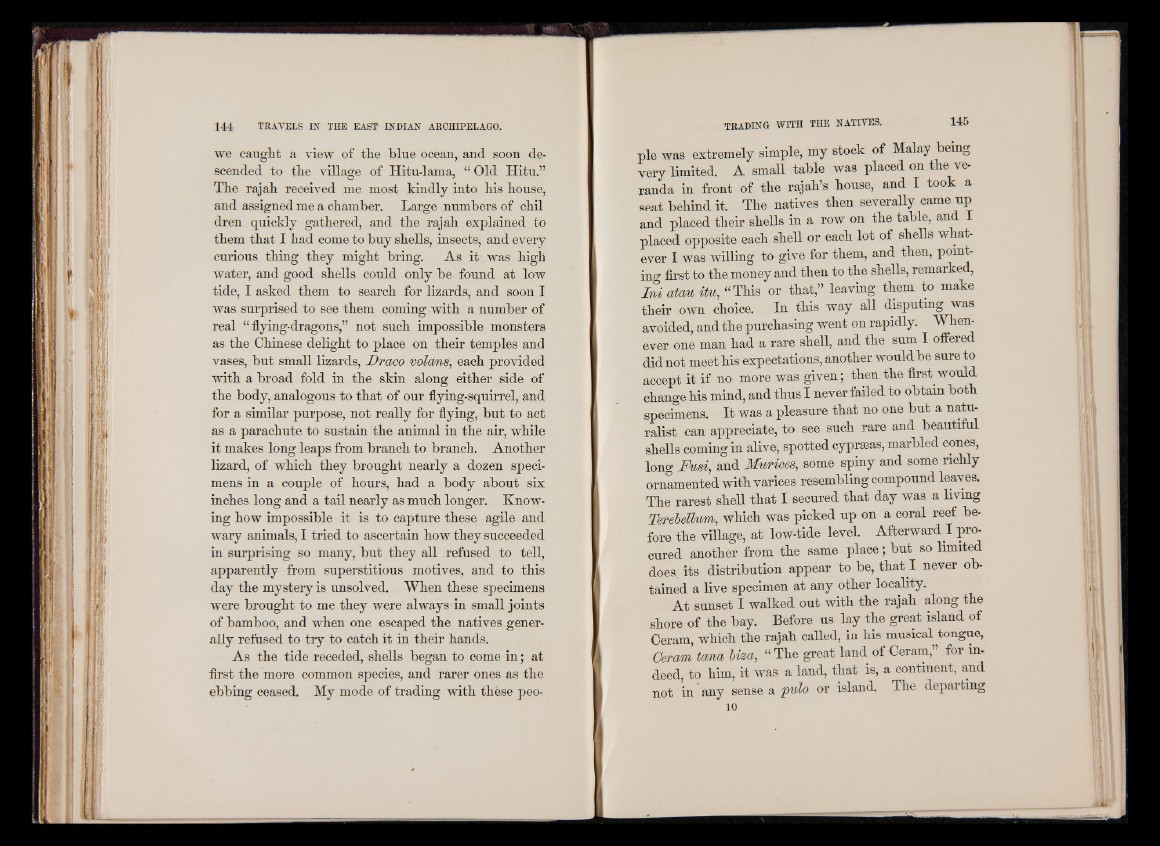
we caught a view of the blue ocean, and soon descended
to the village of Hitu-lama, “ Old Hitu.”
The rajah received me most kindly into his house,
and assigned me a chamber. Large numbers of chil
dren quickly gathered, and the rajah explained to
them that I had come to buy shells, insects, and every
curious thing they might bring. As it' was high
water, and good shells could only be found at low
tide, I asked them to search for lizards, and soon I
was surprised to see them coming with a number of
real “ flying-dragons,” not such impossible monsters
as the Chinese delight to place on their temples and
vases, but small lizards, Draco volans, each provided
with a broad fold in the skin along either side of
the body, analogous to that of our flying-squirrel, and
for a similar purpose, not really for flying, but to act
as a parachute to sustain the animal in the air, while
it makes long leaps from branch to branch. Another
lizard, of which they brought nearly a dozen specimens
in a couple of hours, had a body about six
inches long and a tail nearly as much longer. Knowing
how impossible it is to capture these agile and
wary animals, I tried to ascertain how they succeeded
in surprising so many, but they all refused to tell,
apparently from superstitious motives, and to this
day the mystery is unsolved. When these specimens
were brought to me they were always in small joints
of bamboo, and when one escaped the natives generally
refused to try to catch it in their hands.
As the tide receded, shells began to come in ; at
first the more common species, and rarer ones as the
ebbing ceased. My mode of trading with thèse peopie
was extremely simple, my stock of Malay being
very limited. A small table was placed on the veranda
in front of the rajah’s house, and I took a
seat behind it. The natives then severally came up
and placed their shells in a row on the table, and I
placed opposite each shell or each lot of shells whatever
I was willing to give for them, and then, pointing
first to the money and then to the shells, remarked,
In i atcm iU, “This or that,” leaving them to make
their own choice. Iu this way all disputing was
avoided, and the purchasing went on rapidly. Whenever
one man had a rare shell, and the sum I offered
did not meet his expectations, another wouldbe sure to
accept it if no more was given; then the first would
change his mind, and thus I never failed to obtain both
specimens. It was a pleasure that no one but a naturalist
can appreciate, to see such rare and beautiful
shells coming in alive, spotted cyprseas, marbled cones,
long Fusi, and Mwrices, some spiny and some richly
ornamented with varices resembling compound leaves.
The rarest shell that I secured that day was a living
Terebelkim, which was picked up on a coral reef before
the village, at low-tide level. Afterward I procured
another from the same place; but so limited
does, its distribution appear to be, that I never obtained
a live specimen at any other locality.
At sunset I walked out with the rajah along the
shore of the bay. Before us lay the great island of
Ceram, which the rajah called, in his musical tongue,
Ceram tana Mza, “ The great land of Ceram,” for indeed,
to him, it was a land, that is, a continent, and
not in any sense a pulo or island. The departing
10